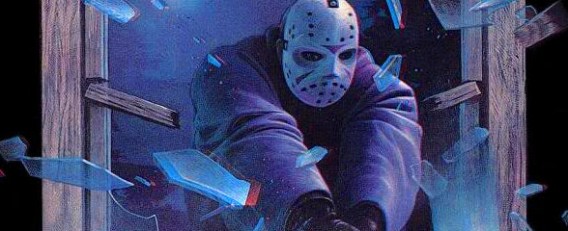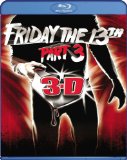Friday the 13th Part 3 (1982) Retrospective

As well as the slasher film, the early 1980s was dominated by 3-D. Just as it had done in the mid-1950s, there had been a major resurgence in the format that had begun with such low key efforts as Comin’ at Ya! and Parasite, which eventually led to a slew of studio pictures that were attempts to revive fledging franchises, such as Jaws 3 and Amityville 3. Friday the 13th had already proven itself to be shamelessly derivative and eager to capitalise on the latest trends and so perhaps it was inevitable that they would eventually turn to 3-D in an effort to boost box office figures. Despite an impressive performance, the butchering of Friday the 13th Part 2 at the hands of the MPAA (Motion Picture Association of America) had left many fans disappointed with the lack of gore that had made the first movie so popular and so Paramount Pictures, desperate for a way to win back their core audience, decided to embrace the 3-D revival.
Due to his hard work and commitment to the production of the second movie, Frank Mancusco Jr. would be promoted to the title of producer for Friday the 13th Part 3, whilst Steve Miner would once again return to the director’s chair. Whilst Paramount had remained at arm’s length during the production of Part 2, purchasing the movie as a negative pick-up upon completion, they had been impressed with the box office figures and decided to take a more hands-on approach for the second sequel. Once again, however, Georgetown would oversee the development, having financed the first two movies, although this time they would have support from a major studio. With the return of 3-D, Paramount knew that they could make a fortune if the format proved as popular as it had been in the 1950s and at first gave thought to producing Star Trek III using the technology.
To help develop the 3D, Paramount’s Frank Mancuso Sr. had approached Martin Jay Sadoff, who had grown up in his neighbourhood and had made an impression with his experiments with the format. Following his work with Astral Bellevue Pathé, Sadoff was contacted by Tony Bishop, who informed him that he was producing the next Friday the 13th movie and that Sadoff’s name had been suggested. After conducting research on the practicality of how the 3-D could be achieved and shown in cinemas nationwide, Sadoff eventually settled on a camera designed by 3-D pioneer Mortimer Marks. In an attempt to revolutionise the format, Sadoff had spent over a year experimenting with 3-D in an attempt to find a new and exciting way with which to thrill modern audiences. Meanwhile, director of photography Gerald Feil, who had previously lensed the cult slasher He Knows You’re Alone, had also been researching the format for a proposed adaption of the classic tale Peter Pan with filmmaker Mike Nichols (The Graduate) that sadly never came to pass. This would prepare him for what he would experience when shooting Friday the 13th Part 3.
With Friday the 13th Part 2‘s Ron Kurz having passed, the task of writing a script that would not only lend itselt to 3-D but also build upon the previous installments fell to Martin Kitrosser, a script supervisor by trade who had worked on the first two movies and would later collaborate with Quentin Tarantino on each of his films. Kitrosser’s subsequent screenwriting career would prove to be somewhat uneventful, with the highlights including Meatballs Part II (a comedy directed by Eyes of a Stranger‘s Ken Wiederhorn) and the straight-to-video sequel Silent Night, Deadly Night 5: The Toy Maker. The script for Friday the 13th Part 3 would ultimately be a collaboration between Kitrosser and his wife, Carol Watson, which would lead to several projects that the duo would work on throughout the 1980s.
Unimpressed with their draft, Miner and Mancuso Jr. would search for a suitable writer to provide uncredited script doctoring, eventually settling on Romanian-born Petru Popescu who, at the time, was studying at the American Film Institute. Despite not being a fan of the slasher film, Popescu worked on the plot and added humour to the script, although character development would prove to be one of the filmmakers’ lesser concerns. Whilst the cast of the previous two installments had boasted appearances from ’50s star Betsy Palmer, the actors that would make up Friday the 13th Part 3 (although they would attempt to downplay its association with the franchise during the early auditions) consisted of newcomers, whilst the filmmakers’ attempts to bring back Part 2‘s heroine, Amy Steel, had proven unsuccessful.
Nineteen-year old Tracie Savage had already forged a career on television during the 1970s with roles in the likes of Little House on the Prairie, due to her mother, Judy Savage, having assisted through her company The Savage Agency. Another client was Paul Kratka, who had appeared in various commercials and on the show General Hospital. Despite having little knowledge of the horror genre, Kratka was advised that the character he was reading for was a carpenter and so attended his callback wearing a parka, jeans and boots and carrying a power saw. Kitrosser and Watson had discovered eighteen-year old Larry Zerner on the streets of Los Angeles, handing out tickets for a screening of the second Max Max movie, The Road Warrior, outside a theatre in Westwood.
During his audition, Zerner was instructed by Miner not to act but just be himself, allowing Zerner to incorporate much of his own personality into that of his character. Having graduated from the University of South Florida, Catherine Parks had been crowned Miss Florida at the Miss America Pageant in 1978, before relocating to California to pursue an acting career. Parks had been in Los Angeles less than six months when she auditioned for Friday the 13th Part 3, which would prove to be her first substantial role. With Steel unable to return to the franchise, the producers were forced to find another lead to play their heroine, resulting in Kratka being called back several times to read alongside actresses. The role would eventually go to Dana Kimmell, who would request that, for personal reasons, references to her and Kratka’s characters having sex be removed from the script.
Unlike its predecessors, Friday the 13th Part 3 would not be shot on the east coast, with filming instead taking place at the Valuzet Movie Ranch in Saugus, California, due to the technical challenges of the 3-D. Following the complications surrounding the casting of their killer, Jason, in Part 2, the role of the antagonist would go to British ex-trapeze artist Richard Brooker, who would ultimately become the first actor to ever don the now infamous hockey mask. Despite its iconic status in popular culture, this was not the mask that was in the script. In fact, even during filming the producers were unsure on what kind of mask Jason should wear, although Miner knew that the character could not use the ‘bag’ that he had worn in the second movie. Whilst many present on set that day have tried to take the credit for the decision, it would be Miner who would give final approval and thus be responsible for the makeover that Jason would receive.
With the 3-D aspect being the main selling point of the picture, some of the cast felt that Miner and the producers had little interest in the actors, which would result in some of the young cast giving less-than-impressive performances. In keeping with the spirit of the franchise the movie would include several memorable set pieces, most notably the death of Kratka’s character, in which Jason would squeeze his skull so hard that his eyes would burst out of their sockets. With the actor having both his head and torso cast in plaster, a dummy was created with a silicon head which Brooker would be able to crush, whilst the eyes moved along on an (almost) invisible wire. Parks would also receive a rather brutal death, with Jason firing a spear into her eye. To achieve this, the spear was sent through the air via a wire, with the footage then cutting to a reaction shot of Parks, thus creating the illusion of contact. This sequence had to be shot in one take, however, as once Parks fell into the water the prosthetic make-up would fall to pieces.
Paramount Pictures released Friday the 13th Part 3 August 13th 1982, the first to be released on a Friday the 13th. On a budget of $2.25m (then the highest in the series but surpassed the following year by Friday the 13th: The Final Chapter), the movie would earn approximately $36.6m at the US box office, not quite as successful as the first film but a far more impressive total than Part 2. The film would be accompanied by a disco theme tune composed by Michael Zager, who had scored minor acclaim during the 1970s, which would be included during the opening credits. The song would become a club hit following the release of the movie and has since become a collector’s item. Perhaps unsurprising, given their track record, the movie was not greeted well by critics, although many fans would also express their disappointment with the movie. However, over the years Part 3 has achieved a ‘so bad it’s good’ cult status and is often considered one of the best installments of the franchise by fans.
|
||||||

